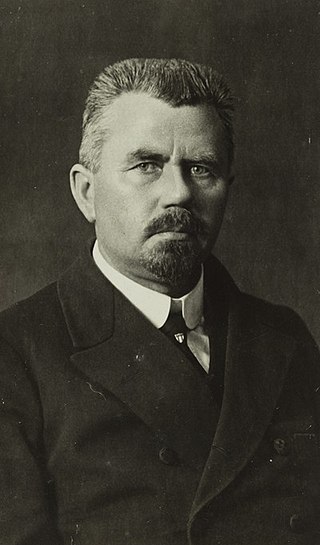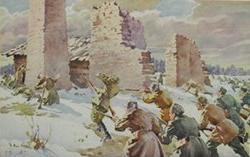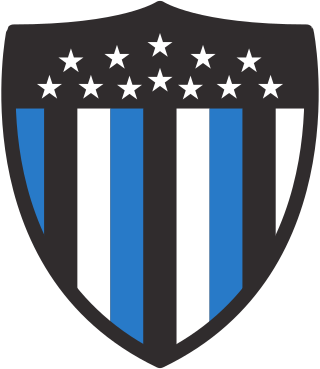
The TK (TK-3) and TKS were Polish tankettes developed during the 1930s and used in the Second World War.

The Renault FT was a French light tank that was among the most revolutionary and influential tank designs in history. The FT was the first production tank to have its armament within a fully rotating turret. The Renault FT's configuration became and remains the standard tank layout. Consequently, some armoured warfare historians have called the Renault FT the world's first modern tank.

The Estonian War of Independence, also known as the Estonian Liberation War, was a defensive campaign of the Estonian Army and its allies, most notably the United Kingdom, against the Bolshevik westward offensive of 1918–1919 and the 1919 aggression of the Baltische Landeswehr. The campaign was the struggle of the newly established democratic nation of Estonia for independence in the aftermath of World War I. It resulted in a victory for Estonia and was concluded in the 1920 Treaty of Tartu.

The Battle of Narva Bridgehead was the campaign that stalled the Soviet Estonian operation in the surroundings of the town of Narva for six months. It was the first phase of the Battle of Narva campaign fought at the Eastern Front during World War II, the second phase being the Battle of Tannenberg Line.

Johan Laidoner was an Estonian general and statesman. He served as Commander‑in‑Chief of the Estonian Armed Forces during the 1918–1920 Estonian War of Independence and was among the most influential people in the Estonian politics between the world wars.

Johan Pitka, VR I/1, was an Estonian entrepreneur, sea captain and a rear admiral (1919). He was the Commander of the Estonian Navy in the Estonian War of Independence.

The British Mark V tank was an upgraded version of the Mark IV tank.

The Battle of Paju was fought in Paju, near Valga, Estonia, on 31 January 1919 during the Estonian War of Independence. After heavy fighting, the Tartu-Valga group of the Estonian Army pushed the Red Latvian Riflemen out of the Paju Manor. It was the fiercest battle in the early period of war. Estonian commander Julius Kuperjanov fell in the fighting.

The British campaign in the Baltic 1918–1919 was a part of the Allied intervention in the Russian Civil War. The codename of the Royal Navy campaign was Operation Red Trek. The intervention played a key role in enabling the establishment of the independent states of Estonia and Latvia. It failed to secure the control of Petrograd by White Russian forces, which was one of the main goals of the campaign.

The coastal batteries presented itself as a powerful strike force of the Estonian Navy between 1918 and 1940.
The Tallinn offensive was a strategic offensive by the Red Army's 2nd Shock and 8th armies and the Baltic Fleet against the German Army Detachment Narwa and Estonian units in mainland Estonia on the Eastern Front of World War II on 17–26 September 1944. Its German counterpart was the abandonment of the Estonian territory in a retreat codenamed Operation Aster.

Arsenal Crossley was an Estonian armored car that was operated between 1926 and 1940. At the time it was introduced the Arsenal Crossley was one of the most modern armored vehicles in the Estonian Army. The vehicle's name is the combination of the two factories that contributed to its production. The car was manufactured in Estonia's Arsenal factory, while the engine was provided by the British company Crossley Motors Ltd and the armored plates were ordered from Sweden.

Two years after the end of the Estonian War of Independence (1918-1920), the Estonian Army consisted of 3 field divisions and a number of small independent battalions and companies (1922).

This is a sub-article to Battle of Narva (1944).

The Meredessantpataljon, was a short-lived Estonian marine infantry battalion during the Estonian War of Independence of the Estonian Defence Forces subject to the Estonian Navy. The battalion was created from the crews of the Estonian surface warships, students and Finnish volunteer soldiers. The battalion was created and later disbanded in Tallinn after it had fulfilled its military objectives in 1919.

The Scouts Battalion is a battalion of the Estonian Land Forces. It is a part of the 1st Infantry Brigade and acts as its rapid response unit. The battalion is currently based at Tapa.

Garford-Putilov armoured cars were an armoured fighting vehicle produced in Russia during the First World War era. They were built on the chassis of Garford Motor Truck Co. lorries imported from the United States.

The Kalev Infantry Battalion is an infantry battalion of the Estonian Land Forces. It is a part of the 1st Infantry Brigade and its primary task is to train conscription-based mechanized infantry units. The battalion has been previously known as the Kalevlaste Maleva and as the Kalev Single Infantry Battalion. The battalion is currently based at Jõhvi.

The Viru Infantry Battalion is a battalion of the Estonian Land Forces. It is a part of the 1st Infantry Brigade and its primary task is to train conscription-based infantry and anti-tank units. The battalion has been previously known as the 4th Infantry Regiment and as the 4th Single Infantry Battalion. The battalion is currently based at Jõhvi.

E-Arsenal was an Estonian arms manufacturing company operating in Tallinn from 1994 to 2012.



























